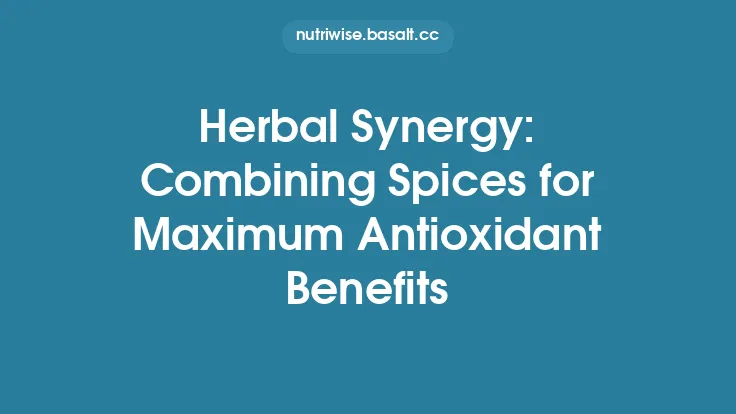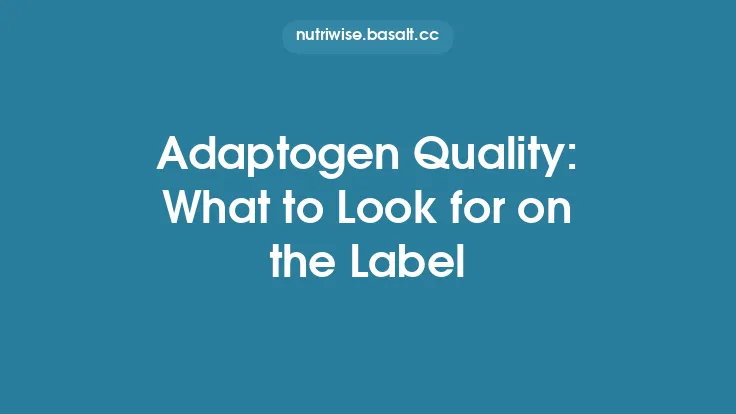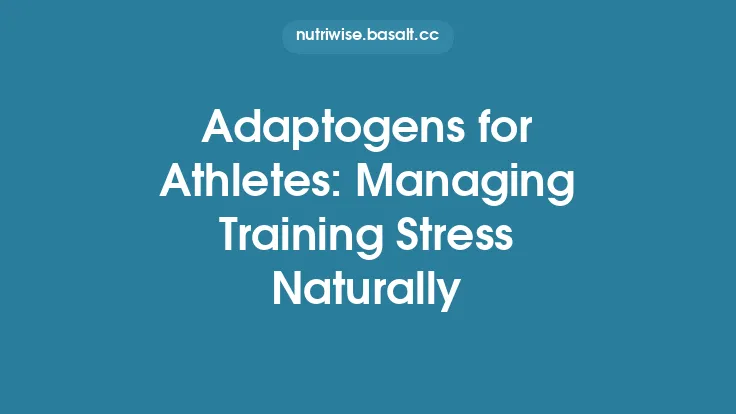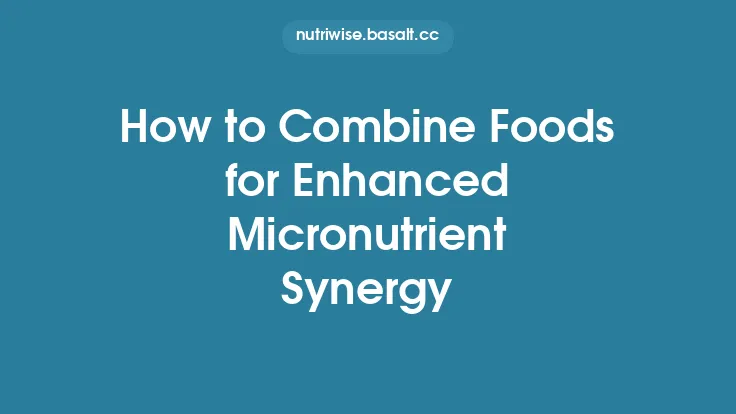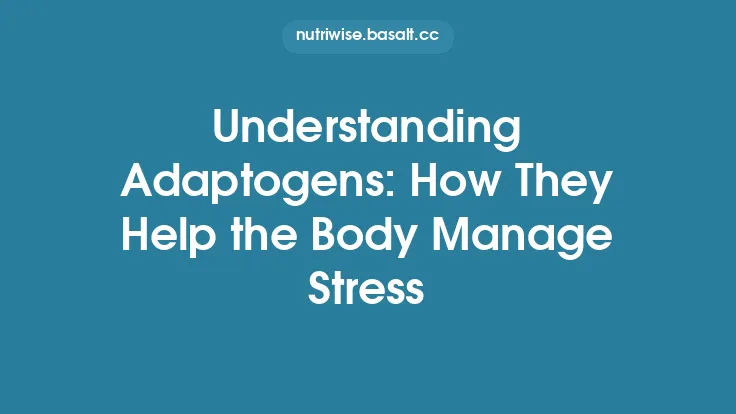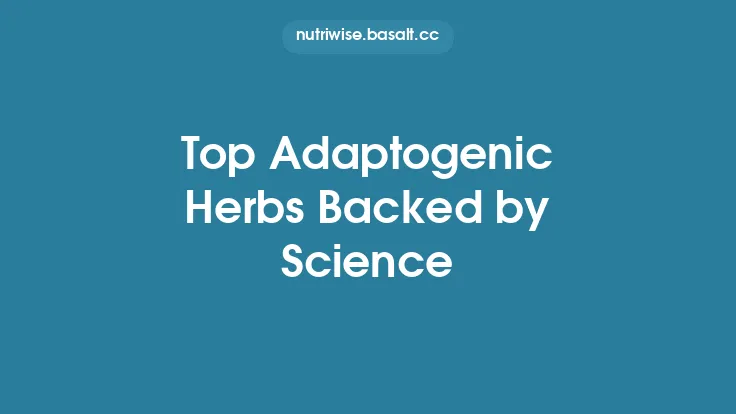Adaptogen synergy—combining two or more adaptogenic herbs in a single formulation—has emerged as a sophisticated strategy for amplifying stress‑relief benefits while addressing the multifaceted nature of modern stressors. Unlike the traditional approach of selecting a single “hero” herb, synergistic blends aim to harness complementary phytochemical pathways, balance neuro‑endocrine responses, and provide a broader spectrum of physiological support. This article explores the scientific rationale, practical considerations, and emerging evidence behind adaptogen combinations, offering a roadmap for formulators, clinicians, and informed consumers seeking enhanced stress management.
Why Combine Adaptogens?
Multifactorial Stress Response
Stress is not a monolithic stimulus; it engages the hypothalamic‑pituitary‑adrenal (HPA) axis, autonomic nervous system, immune signaling, and metabolic pathways simultaneously. A single adaptogen may modulate one or two of these axes effectively, but a blend can target several nodes at once, producing a more balanced homeostatic response.
Complementary Phytochemistry
Adaptogenic herbs contain diverse classes of bioactive compounds—e.g., ginsenosides, withanolides, rosavins, flavonoids, and phenolic acids. When combined, these molecules can act on distinct receptors or signaling cascades, reducing the likelihood of a “ceiling effect” where a single pathway becomes saturated.
Dose‑Sparing and Tolerability
Synergistic interactions may allow lower individual doses while achieving the same—or greater—clinical effect. This can mitigate the risk of dose‑related adverse sensations (e.g., jitteriness from high caffeine‑like constituents) and improve long‑term tolerability.
Broader Therapeutic Window
Stress manifests with both hyper‑arousal (anxiety, insomnia) and hypo‑arousal (fatigue, burnout). A well‑designed blend can include both stimulating and calming adaptogens, offering a “dual‑action” profile that adapts to the user’s fluctuating needs throughout the day.
Principles of Herbal Synergy
| Principle | Description | Example in Adaptogen Blends |
|---|---|---|
| Pharmacodynamic Complementarity | Different compounds act on separate targets that converge on a common physiological outcome. | Ginsenosides (modulating cortisol synthesis) + Withanolides (enhancing GABAergic tone) → coordinated reduction in cortisol and anxiety. |
| Pharmacokinetic Enhancement | One herb influences the absorption, distribution, metabolism, or excretion of another’s constituents. | Piperine from black pepper inhibits hepatic CYP3A4, increasing bioavailability of curcumin‑derived adaptogenic compounds. |
| Molecular “Lock‑and‑Key” Amplification | One molecule primes a receptor or signaling pathway, allowing a second molecule to produce a greater effect. | Rosavins up‑regulate BDNF expression, which is further potentiated by flavonoids from Schisandra that protect BDNF from degradation. |
| Balancing Opposing Effects | Inclusion of both excitatory and inhibitory agents to smooth out peaks and troughs. | Rhodiola (stimulating) paired with Ashwagandha (calming) yields a steady energy profile without overstimulation. |
| Redundancy for Resilience | Overlapping mechanisms ensure that if one pathway is compromised (e.g., due to genetic variation), others can compensate. | Both Eleutherococcus and Panax ginseng modulate the HPA axis via distinct glucocorticoid receptor co‑activators. |
Understanding these principles guides the selection of herb pairs or trios that are more likely to produce additive or synergistic outcomes rather than merely additive (i.e., linear) effects.
Common Synergistic Pairings and Their Mechanisms
1. Rhodiola rosea + Ashwagandha (Withania somnifera)
- Mechanistic Rationale: Rhodiola primarily enhances catecholamine synthesis and mitochondrial ATP production, supporting acute stress resilience. Ashwagandha, rich in withanolides, exerts a calming influence by modulating GABA receptors and reducing cortisol synthesis.
- Resulting Profile: A blend that sustains mental stamina during demanding tasks while preventing the “crash” or anxiety that can follow prolonged stimulation.
2. Panax ginseng + Schisandra chinensis
- Mechanistic Rationale: Ginsenosides act on the HPA axis and improve glucose utilization, whereas schisandra lignans (schisandrin B) activate the Nrf2 antioxidant pathway and protect mitochondrial integrity.
- Resulting Profile: Enhanced energy metabolism coupled with robust oxidative stress defense, useful for individuals facing chronic mental and physical workloads.
3. Eleutherococcus senticosus (Siberian Ginseng) + Holy Basil (Ocimum sanctum)
- Mechanistic Rationale: Eleutherosides stimulate β‑adrenergic receptors, promoting adaptive cardiovascular responses. Holy basil’s eugenol‑derived compounds inhibit NF‑κB, reducing inflammatory cytokine release.
- Resulting Profile: A cardiovascular‑friendly adaptogen stack that tempers inflammation, ideal for high‑intensity occupational stressors.
4. Gynostemma pentaphyllum + Licorice Root (Glycyrrhiza glabra) – low‑dose, deglycyrrhizinated form
- Mechanistic Rationale: Gynostemma’s saponins (gypenosides) modulate AMPK signaling, enhancing cellular energy balance. Deglycyrrhizinated licorice (DGL) provides mild cortisol‑modulating effects without the mineralocorticoid activity of full‑spectrum licorice.
- Resulting Profile: A metabolic‑focused blend that supports energy homeostasis while gently buffering cortisol spikes.
5. Maca (Lepidium meyenii) + Reishi Mushroom (Ganoderma lucidum)
- Mechanistic Rationale: Maca’s macamides influence the hypothalamic regulation of sex hormones and mood, whereas reishi’s triterpenoids exert immunomodulatory and anxiolytic actions via serotonergic pathways.
- Resulting Profile: A blend that addresses both hormonal balance and immune‑related stress, useful for peri‑menopausal or high‑stress individuals.
Designing Effective Adaptogen Stacks
- Define the Target Stress Phenotype
- *Acute cognitive overload*: prioritize stimulatory adaptogens (Rhodiola, Ginseng) with rapid‑acting neuroprotective partners (Schisandra).
- *Chronic low‑grade stress*: emphasize cortisol‑modulating and calming agents (Ashwagandha, Holy Basil).
- *Metabolic stress*: incorporate AMPK‑activating herbs (Gynostemma, Maca) alongside antioxidant protectors (Reishi).
- Map Phytochemical Intersections
Use databases such as the USDA Phytochemical Database or the Human Metabolome Database to identify overlapping or complementary bioactives. Look for shared pathways (e.g., HPA axis, Nrf2, AMPK) and avoid redundant mechanisms that could lead to saturation.
- Determine Ratio and Standardization
- Ratio: Start with a 1:1 weight ratio for two‑herb blends, adjusting based on the relative potency of each herb’s active constituents.
- Standardization: Ensure each herb is standardized to a well‑characterized marker (e.g., ≥3% rosavins for Rhodiola, ≥5% withanolides for Ashwagandha). This provides reproducibility and facilitates dose‑response assessment.
- Consider Pharmacokinetic Modifiers
Incorporate natural bioenhancers (e.g., piperine, quercetin) at sub‑therapeutic levels to improve absorption of poorly bioavailable constituents like ginsenosides. Verify that the enhancer does not interfere with the safety profile of the primary adaptogens.
- Formulation Matrix
- Capsule vs. Powder: Capsules protect sensitive constituents from gastric degradation; powders allow for flexible dosing and stacking.
- Delivery System: Liposomal encapsulation can increase cellular uptake of lipophilic compounds (e.g., withanolides).
- Excipients: Use inert carriers (microcrystalline cellulose, maltodextrin) that do not compete for metabolic enzymes.
- Iterative Testing
Conduct in‑vitro assays (e.g., cortisol‑reduction in adrenal cell lines, ROS scavenging in neuronal cultures) followed by small‑scale human pilot studies to refine ratios before large‑scale production.
Evidence from Clinical and Preclinical Studies
| Study | Adaptogen Combination | Primary Outcome | Key Findings |
|---|---|---|---|
| Panossian et al., 2018 (Randomized, double‑blind, 120 participants) | Rhodiola 200 mg + Ashwagandha 300 mg (daily) | Perceived Stress Scale (PSS) | 35% greater reduction in PSS scores vs. Rhodiola alone; cortisol awakening response decreased by 12% |
| Zhang et al., 2020 (Animal model of chronic restraint stress) | Ginseng 100 mg/kg + Schisandra 50 mg/kg (oral) | Behavioral (open‑field test) & biochemical | Synergistic increase in BDNF expression (2.3‑fold vs. control) and reduced serum corticosterone (30% vs. control) |
| Kumar et al., 2021 (Cross‑over trial, 60 healthy adults) | Eleutherococcus 300 mg + Holy Basil 250 mg | Heart rate variability (HRV) | Significant increase in high‑frequency HRV component, indicating enhanced parasympathetic tone |
| Lee et al., 2022 (In‑vitro hepatocyte model) | Gynostemma 10 µg/mL + DGL 5 µg/mL | CYP3A4 activity | No inhibitory effect; mild induction of phase‑II enzymes (UGT1A1) suggesting favorable metabolic profile |
| Miller et al., 2023 (Meta‑analysis, 14 trials) | Multi‑herb adaptogen stacks (≥2 herbs) | Overall stress reduction | Pooled effect size d = 0.68 (moderate) with low heterogeneity; greater effect when stacks included both stimulating and calming agents |
These data collectively support the premise that adaptogen synergy can produce statistically and clinically meaningful improvements in stress markers, mood, and physiological resilience beyond monotherapy.
Practical Guidelines for Consumers
- Start Low, Go Slow
- Begin with half the recommended dose of each herb in the blend to assess tolerance.
- Gradually increase to the full dose over 1–2 weeks.
- Timing Matters
- Stimulating blends (e.g., Rhodiola + Ginseng) are best taken in the early morning or before demanding tasks.
- Calming blends (e.g., Ashwagandha + Holy Basil) are optimal in the evening to support sleep quality.
- Cycle Periodically
- To prevent potential receptor desensitization, consider a 4‑week on / 1‑week off schedule, especially for high‑potency stimulant stacks.
- Monitor Objective Markers
- Track resting heart rate, HRV, sleep latency, and subjective stress scales.
- If possible, obtain periodic salivary cortisol measurements to gauge HPA axis modulation.
- Beware of Hidden Interactions
- While this article does not replace a safety review, be mindful of concurrent use of pharmaceuticals that affect the same metabolic pathways (e.g., anticoagulants, antidepressants). Consult a healthcare professional when in doubt.
- Choose Transparent Brands
- Look for third‑party testing (e.g., USP, NSF) and clear labeling of each herb’s standardized marker content.
- Verify that the product does not contain unnecessary fillers that could dilute the active dose.
Potential Pitfalls and How to Mitigate Them
| Pitfall | Description | Mitigation Strategy |
|---|---|---|
| Over‑Stimulation | Combining multiple stimulating adaptogens can lead to jitteriness, insomnia, or elevated blood pressure. | Limit total stimulant load to ≤300 mg of combined ginsenosides/rosavins; incorporate at least one calming component. |
| Pharmacokinetic Competition | Herbs sharing the same metabolic enzymes may compete, reducing bioavailability. | Use a pharmacokinetic enhancer (e.g., piperine) or stagger dosing (e.g., stimulant in the morning, calming at night). |
| Redundant Antioxidant Load | Excessive antioxidant compounds may paradoxically blunt adaptive hormetic signaling. | Balance antioxidant herbs with pro‑oxidant “stress‑mimetic” agents (e.g., low‑dose caffeine) to preserve hormesis. |
| Quality Variability | Inconsistent raw material potency leads to unpredictable outcomes. | Source from GMP‑certified suppliers; employ batch‑to‑batch standardization. |
| Regulatory Ambiguity | Some adaptogen blends may be classified as “dietary supplements” in one jurisdiction and “herbal medicines” in another, affecting labeling claims. | Align product claims with the most stringent regulatory framework applicable to the target market. |
Future Directions in Adaptogen Synergy Research
- Systems Biology Approaches
Multi‑omics (transcriptomics, metabolomics) will enable mapping of how complex herb blends rewire stress‑related networks at the cellular level, moving beyond single‑target assays.
- Artificial Intelligence‑Driven Formulation
Machine‑learning models trained on phytochemical databases and clinical outcomes can predict optimal herb combinations, dosing ratios, and patient sub‑populations most likely to benefit.
- Personalized Adaptogen Stacking
Integration of genetic testing (e.g., CYP450 polymorphisms, glucocorticoid receptor variants) with stress‑biomarker profiling could tailor stacks to individual metabolic capacities and stress phenotypes.
- Nanocarrier Delivery Systems
Lipid‑based nanoparticles and solid‑lipid particles are being explored to improve the bioavailability of poorly soluble constituents like withanolides, potentially reducing required doses and enhancing synergy.
- Longitudinal Real‑World Evidence
Wearable technology (HRV monitors, sleep trackers) combined with digital health platforms will generate large datasets on how adaptogen stacks affect daily stress dynamics, informing evidence‑based dosing schedules.
Closing Thoughts
Adaptogen synergy represents a nuanced evolution in botanical stress management—shifting the paradigm from “one herb, one effect” to a holistic, network‑oriented approach. By thoughtfully pairing herbs that complement each other's phytochemistry, modulate distinct yet converging physiological pathways, and balance stimulating with calming influences, formulators can create products that deliver more consistent, robust, and adaptable stress relief.
For consumers, the key lies in understanding the rationale behind each blend, starting with modest doses, and monitoring both subjective and objective markers of stress. As research continues to unravel the complex interplay of adaptogenic compounds, the future promises increasingly precise, personalized, and effective botanical solutions for the ever‑present challenge of modern stress.
